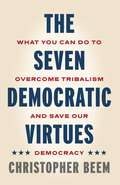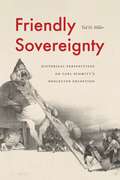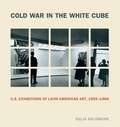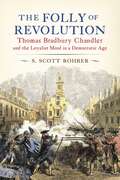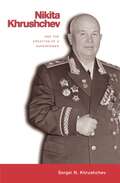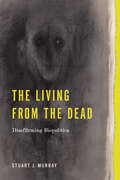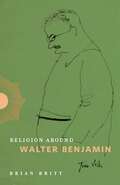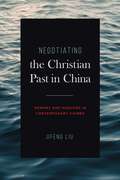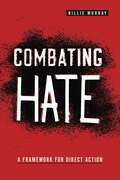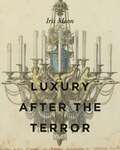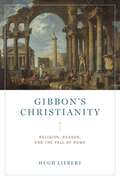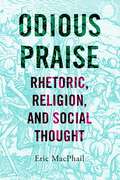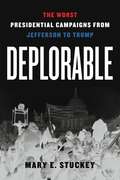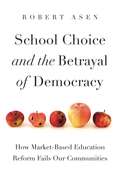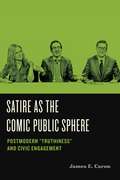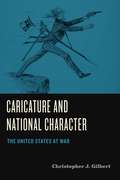- Table View
- List View
Prints of a New Kind: Political Caricature in the United States, 1789–1828
by Allison M. StaggPrints of a New Kind details the political strategies and scandals that inspired the first generation of American caricaturists to share news and opinions with their audiences in shockingly radical ways. Complementing studies on British and European printmaking, this book is a survey and catalogue of all known American political caricatures created in the country’s transformative early years, as the nation sought to define itself in relation to European models of governance and artistry.Allison Stagg examines printed caricatures that mocked events reported in newspapers and politicians in the United States’ fledgling government, reactions captured in the personal papers of the politicians being satirized, and the lives of the artists who satirized them. Stagg’s work fills a large gap in early American scholarship, one that has escaped thorough art-historical attention because of the rarity of extant images and the lack of understanding of how these images fit into their political context. Featuring 125 images, many published here for the first time since their original appearance, and a comprehensive appendix that includes a checklist of caricature prints with dates, titles, artists, references, and other essential information, Prints of a New Kind will be welcomed by scholars and students of early American history and art history as well as visual, material, and print culture.
The Seven Democratic Virtues: What You Can Do to Overcome Tribalism and Save Our Democracy
by Christopher BeemThe insurrection of January 6, 2021, demonstrated conclusively that tribalism in the United States has become dangerous. The “other side” is no longer viewed as a well-intentioned opponent but as an existential threat. If we don’t change course, American democracy is far from assured.This book outlines specific steps that average citizens can take to back the nation away from the brink. Instead of looking to political leaders, institutions, or policy for solutions to extreme partisanship, Christopher Beem argues that concerned citizens can and must take up the cause. He spells out seven civic practices we can all follow that will help us work against our antidemocratic tendencies and reorient the nation toward the “more perfect union” of our Founders. Beem’s road map to restore our democracy draws on thinkers from Aristotle and Thomas Aquinas to James Madison, Hannah Arendt, Abraham Lincoln, and Franklin Delano Roosevelt. Empathetic and eminently reasonable, The Seven Democratic Virtues presents practical advice for what each of us can do to change the political discourse and save our democracy. This is necessary reading for our politics today—and in the future.
Friendly Sovereignty: Historical Perspectives on Carl Schmitt's Neglected Exception
by Ted H. MillerOver the last one hundred years, the term “sovereignty” has often been associated with the capacity of leaders to declare emergencies and to unleash harmful, extralegal force against those deemed enemies. Friendly Sovereignty explores the blind spots of this influential perspective.Ted H. Miller challenges the view of sovereignty propounded by Carl Schmitt, the Weimar and Nazi–period jurist and political theorist whose theory undergirds this understanding of sovereignty. Claiming a return to concepts of sovereignty forgotten by his liberal contemporaries, Schmitt was preoccupied with the legal exceptions required, he said, to rescue polities in crisis. Much is missing from what Schmitt harvests from the past. His framework systematically overlooks another extralegal power, one that often caused consternation, even among absolutists like Thomas Hobbes. Sovereigns also made exceptions for friends, allies, and dependents. Friendly Sovereignty plumbs the history of political thought about sovereignty to illustrate this other side of the sovereign’s exception-making power. At the core of this extensive study are three thinkers, each of whom stakes out a distinct position on the merits and demerits of a “friendly sovereign”: the nineteenth-century historian Jules Michelet, the seventeenth-century political philosopher Thomas Hobbes, and Seneca, the ancient Stoic and teacher of Nero.Analytically rigorous and thorough in its intellectual history, Friendly Sovereignty presents a more comprehensive understanding of sovereignty than the one typically taught today. It will be particularly useful to scholars and students of political theory and philosophy.
Cold War in the White Cube: U.S. Exhibitions of Latin American Art, 1959–1968 (Refiguring Modernism)
by Delia SolomonsIn 1959, the very year the Cuban Revolution amplified Cold War tensions in the Americas, museumgoers in the United States witnessed a sudden surge in major exhibitions of Latin American art. Surveying the 1960s boom of such exhibits, this book documents how art produced in regions considered susceptible to communist influence was staged on U.S. soil for U.S. audiences.Held in high-profile venues such as the Guggenheim Museum, the Walker Art Center, MoMA, and the Art Institute of Chicago, the exhibitions of the 1960s Latin American art boom did not define a single stylistic trend or the art of a single nation but rather attempted to frame Latin America as a unified whole for U.S. audiences. Delia Solomons calls attention to disruptive artworks that rebelled against the curatorial frames purporting to hold them and reveals these exhibitions to be complex contact zones in which competing voices collided. Ultimately, through multiple means—including choosing to exclude artworks with readily decipherable political messages and evading references to contemporary inter-American frictions—the U.S. curators who organized these shows crafted projections of Pan-American partnership and harmony, with the United States as leader, interpreter, and good neighbor, during an era of brutal U.S. interference across the Americas.Theoretically sophisticated and highly original, this survey of Cold War–era Latin American art exhibits sheds light on the midcentury history of major U.S. art museums and makes an important contribution to the fields of museum studies, art history, and Latin American modernist art.
The Folly of Revolution: Thomas Bradbury Chandler and the Loyalist Mind in a Democratic Age
by S. Scott RohrerIn this penetrating biography of Thomas Bradbury Chandler, S. Scott Rohrer takes readers deep into the intellectual world of a leading loyalist who defended monarchy, rejected rebellion and democracy, and opposed the American Revolution.Talented, hardworking, and erudite, this Anglican minister from New Jersey possessed one of the Church of England’s most outstanding minds. Chandler was an Anglican leader in the 1760s and a key strategist in the effort to strengthen the American church in the years preceding the Revolution. He headed the campaign to create an Anglican bishopric in America—a cause that helped inflame tensions with American radicals unhappy with British policies. And, in the 1770s, his writings provided some of the most trenchant criticisms of the American revolutionary movement, raising fundamental questions about obedience, subordination, and rebellion that undercut Whig assertions about republicanism and popular control. Working from Chandler’s library catalog and other primary sources, Rohrer digs into Chandler’s political and religious beliefs, exploring their origins and the events in British history that shaped them.An intriguing and thoughtful reappraisal of a consequential figure in early American history, this biography will captivate students, scholars, and lay readers interested in politics and religion in Revolutionary-era America.
Nikita Khrushchev and the Creation of a Superpower
by Sergei KhrushchevMore is known about Nikita Khrushchev than about many former Soviet leaders, partly because of his own efforts to communicate through speeches, interviews, and memoirs. (A partial version of his memoirs was published in three volumes in 1970, 1974, and 1990, and a complete version was published in Russia in 1999 and will appear in an English translation to be published by Penn State Press.) But even with the opening of party and state archives in 1991, as William Taubman points out in his Foreword, many questions remain unanswered. "How did Khrushchev manage not only to survive Stalin but to succeed him? What led him to denounce his former master [an event that some interpreters herald as the first act in the drama that led to the end of the USSR]? How could a man of minimal formal education direct the affairs of a vast intercontinental empire in the nuclear age? Why did Khrushchev’s attempt to ease East-West tensions result in two of the worst crises of the Cold War in Berlin and Cuba? To resolve these and other contradictions, we need more than policy documents from archives and memoirs from associates. We need firsthand testimony by family members who knew Khrushchev best, especially by his only surviving son, Sergei, in whom he often confided."As Sergei says, "During the Cold War our nations lived on opposite sides of the Iron Curtain, and not only was it an Iron Curtain but it was also a mirror: one side perceived the other as the 'evil empire,' and vice versa; so, too, each side feared the other would start a nuclear war. Neither side could understand the real reasons behind many decisions because Americans and Russians, representing different cultures, think differently. The result was a Cold War filled with misperceptions that could easily have led to tragedy, and we are lucky it never happened. And still, after the Cold War, American-Russian relations are based on many misunderstandings." In this book Sergei tells the story of how the Cold War happened in reality from the Russian side, not from the American side, and this is his most important contribution.Sergei N. Khrushchev was born in 1935 when his father was Moscow party chief. He accompanied his father on major foreign trips—to Great Britain in 1956, East Germany in 1958, the United States in 1959, Egypt in 1964, among many others. After he became a control systems engineer and went to work for leading Soviet missile designer Vladimir Chelomei, Sergei attended many meetings at which his father transacted business with key leaders in the Soviet defense establishment. He has received many awards and honors for his work in computer science, missile design, and space research. Besides his many technical publications, he has published widely on political and economic issues. In 1991 Little Brown published his memoir about his father’s last years, Khrushchev on Khrushchev. In that same year he received an appointment to the Center for Foreign Policy Development of the Thomas J. Watson Institute for International Studies at Brown University, where he is today. He and his wife, Valentina Nikolayevna, applied for U. S. citizenship in 1999, an event widely covered in the media.
The Living from the Dead: Disaffirming Biopolitics (RSA Series in Transdisciplinary Rhetoric)
by Stuart J. MurrayIn a society that aims above all to safeguard life, how might we reckon with ethical responsibility when we are complicit in sacrificial economies that produce and tolerate death as a necessity of life?Arguing that biopower can be fully exposed only through an analysis of those whom society has “let die,” Stuart J. Murray employs a series of transdisciplinary case studies to uncover the structural and rhetorical conditions through which biopower works. These case studies include the concept of “sacrifice” in the “war” against COVID-19, where emergent cultures of pandemic “resistance” are explored alongside suicide bombings and military suicides; the California mass hunger strikes of 2013; legal cases involving “preventable” and “untimely” childhood deaths, exposing the irreconcilable claims of anti-vaxxers and Indigenous peoples; and the videorecording of the death of a disabled Black man. Murray demonstrates that active resistance to biopower inevitably reproduces tropes of “making live” and “letting die.” His counter to this fact is a critical stance of disaffirmation, one in which death disrupts the politics of life itself.A philosophically nuanced critique of biopower, The Living from the Dead is a meditation on life, death, power, language, and control in the twenty-first century. It will appeal to students and scholars of rhetoric, philosophy, and critical theory.
Religion Around Walter Benjamin (Religion Around)
by Brian BrittThis book shows how institutional religion and the religiosity of political and cultural life provide a necessary dimension to Walter Benjamin, one of the twentieth century’s greatest thinkers. Lived religion surrounded Benjamin, whose upper-middle-class Jewish family celebrated Christmas and Hanukkah in Berlin as the turmoil of war, collapsing empires, and modern urban life gave rise to the Nazi regime that would destroy most of Europe’s Jews, including Benjamin himself. Documenting the vitality and diversity of religious life that surrounded Benjamin in Germany, France, and beyond, Brian Britt shows the extent to which religious communities and traditions, especially those of Christians, influenced his work. Britt surveys and analyzes the intellectual, cultural, and social contexts of religion in Benjamin’s world and broadens the religious frame around discussions of his work to include lived religion—the daily practices of ordinary people. Seeing religion around Benjamin requires looking at forms of life and institutions that he rarely discussed. As Britt shows, dramatic changes in religious practices, particularly in Berlin, reflected broader political and cultural currents that would soon transform the lives of all Europeans.An original perspective on the religious context of a thinker who habitually raised questions about the survival of religion in modernity, Religion Around Walter Benjamin contributes to wider discussions of religious tradition and secular modernity in religious and cultural studies. It provides a foundational overview and introduction to the context of Benjamin’s writing that will be appreciated by scholars and students alike.
Negotiating the Christian Past in China: Memory and Missions in Contemporary Xiamen (World Christianity)
by Jifeng LiuAt the turn of the twenty-first century, Xiamen’s pursuit of World Heritage Site designation from UNESCO stimulated considerable interest in the city’s Christian past. History enthusiasts, both Christian and non-Christian, devoted themselves to reinterpreting the legacy of missionaries and challenged official narratives of Christianity’s troubled associations with Western imperialism. In this book, Jifeng Liu documents the tension that has inevitably emerged between the established official history and these popular efforts.This volume elucidates the ways in which Christianity has become an integral part of Xiamen, a Chinese city profoundly influenced by Western missionaries. Drawing on extensive interviews, locally produced histories, and observations of historical celebrations, Liu provides an intimate portrait of the people who navigate ideological issues to reconstruct a Christian past, reproduce religious histories, and redefine local power structures in the shadow of the state. Liu makes a compelling argument that a Christian past is being constructed that combines official frameworks, unofficial practices, and nostalgia into social memory, a realm of dynamic negotiation that is neither dominated by the authoritarian state nor characterized by popular resistance. In this way, Negotiating the Christian Past in China illustrates the complexities of memory and missions in shaping the city’s cultural landscape, church-state dynamics, and global aspirations.This groundbreaking study assumes a perspective of globalization and localization, in both the past and the present, to better understand Chinese Christianity in a local, national, and global context. It will be welcomed by scholars of religious studies and world Christianity, and by those interested in the church-state relationship in China.
Combating Hate: A Framework for Direct Action (Rhetoric and Democratic Deliberation)
by Billie MurrayThe United States has a hate problem. In recent years, hate speech has led not only to deep division in our politics but also to violence, murder, and even insurrection. And yet established constitutional jurisprudence holds that all speech is protected as “content neutral” and that the proper democratic response to hateful expression is not regulation but “more speech.” So how can ordinary citizens stand up to hate groups when the state will not?In Combating Hate, Billie Murray proposes an answer to this question. As a participant in anti-racist and anti-fascist protests, including demonstrations against the Ku Klux Klan, neo-Nazis, and the Westboro Baptist Church, Murray witnessed firsthand the limitations of the “more speech” approach as well as the combative tactics of anti-fascist activists. She argues that this latter group, commonly known as antifa, embodies a radically different strategy for combating hate, one that explodes the myth of content neutrality and reveals hate speech to be a tactic of fascist organizing with very real, highly anti-democratic consequences. Drawing on communication theory and this on-the-ground experience, Murray presents a new strategy, which she calls “allied tactics,” rooted in the commitment to affirm, support, and even protect those who are the victims of hate speech.Engaging and sophisticated, Combating Hate contends that there are concrete ways to fight hate speech from the front lines. Murray’s urgent argument that we reconsider how to confront and fight this blight on American life is essential reading for the current era.
Luxury After the Terror
by Iris MoonWhen Louis XVI was guillotined on January 21, 1793, vast networks of production that had provided splendor and sophistication to the royal court were severed. Although the king’s royal possessions—from drapery and tableware to clocks and furniture suites—were scattered and destroyed, many of the artists who made them found ways to survive. This book explores the fabrication, circulation, and survival of French luxury after the death of the king.Spanning the final years of the ancien régime from the 1790s to the first two decades of the nineteenth century, this richly illustrated book positions luxury within the turbulent politics of dispersal, disinheritance, and dispossession. Exploring exceptional works created from silver, silk, wood, and porcelain as well as unrealized architectural projects, Iris Moon presents new perspectives on the changing meanings of luxury in the revolutionary and Napoleonic periods, a time when artists were forced into hiding, exile, or emigration. Moon draws on her expertise as a curator to revise conventional accounts of the so-called Louis XVI style, arguing that it was only after the revolutionary auctions liquidated the king’s collections that their provenance accrued deeper cultural meanings as objects with both a royal imprimatur and a threatening reactionary potential.Lively and accessible, this thought-provoking study will be of interest to curators, art historians, scholars, and students of the decorative arts as well as specialists in the French Revolution.
Luxury After the Terror
by Iris MoonWhen Louis XVI was guillotined on January 21, 1793, vast networks of production that had provided splendor and sophistication to the royal court were severed. Although the king’s royal possessions—from drapery and tableware to clocks and furniture suites—were scattered and destroyed, many of the artists who made them found ways to survive. This book explores the fabrication, circulation, and survival of French luxury after the death of the king.Spanning the final years of the ancien régime from the 1790s to the first two decades of the nineteenth century, this richly illustrated book positions luxury within the turbulent politics of dispersal, disinheritance, and dispossession. Exploring exceptional works created from silver, silk, wood, and porcelain as well as unrealized architectural projects, Iris Moon presents new perspectives on the changing meanings of luxury in the revolutionary and Napoleonic periods, a time when artists were forced into hiding, exile, or emigration. Moon draws on her expertise as a curator to revise conventional accounts of the so-called Louis XVI style, arguing that it was only after the revolutionary auctions liquidated the king’s collections that their provenance accrued deeper cultural meanings as objects with both a royal imprimatur and a threatening reactionary potential.Lively and accessible, this thought-provoking study will be of interest to curators, art historians, scholars, and students of the decorative arts as well as specialists in the French Revolution.
Gibbon’s Christianity: Religion, Reason, and the Fall of Rome
by Hugh LiebertThere has never been much doubt about the faith of the “infidel historian” Edward Gibbon. But for all of Gibbon’s skepticism regarding Christianity’s central doctrines, the author of The History of the Decline and Fall of the Roman Empire did not merely seek to oppose Christianity; he confronted it as a philosophical and historical puzzle. Gibbon’s Christianity tallies the results and conditions of that confrontation.Using rich correspondence, private journals, early works, and memoirs that were never completed, Hugh Liebert provides intimate access to Gibbon’s life in order to better understand his complex relationship with religion. Approaching the Decline and Fall from the context surrounding its conception, Liebert shows how Gibbon adapted explanations of the Roman republic’s rise to account for a new spiritual republic and, subsequently, the rise of modern Europe. Taken together, Liebert’s analysis of this context, including the nuance of Gibbon’s relationship to Christianity, and his readings of Gibbon’s better- and lesser-known texts suggest a historian more eager to comprehend Christianity’s worldly power than to sneer at or dismiss it.Eminently readable and wholly accessible to anyone interested in or familiar with the Decline and Fall, this groundbreaking reassessment of Gibbon’s most famous work will appeal especially to scholars of eighteenth-century studies.
Odious Praise: Rhetoric, Religion, and Social Thought
by Eric MacPhailThis book reveals a tradition of thought overlooked in our intellectual history but enormously influential even now: the tradition of odious praise. Distinct from more conventional rhetorical exercises, such as panegyric or the funeral oration, odious praise uses acclaim to censure or to critique. This book reassesses the genre of praise-and-blame rhetoric by considering the potential of odious praise to undermine consensus and to challenge a society’s normative values.Surveying literature from ancient Greece to Renaissance Europe, Eric MacPhail identifies a tradition of epideictic rhetoric that began with the sophists but was cultivated and employed most vigorously by Renaissance political thinkers. Presenting examples from the writings of Lorenzo Valla, Niccolò Machiavelli, Desiderius Erasmus, Michel de Montaigne, Joachim du Bellay, and Jean Bodin, among others, MacPhail shows that by inscribing a positive value to an object worthy of blame, cultural values are turned on their head. MacPhail traces the use of this technique to critique the values of the classical and scholastic traditions. Recognizing and engaging with this tradition, MacPhail argues, can reinvigorate our study of the history of social thought and reveal further the roots of modern social science.Rigorous and lucid, Odious Praise presents a rhetoric capable of suspending and thus critiquing the values of a culture, and in doing so, it uncovers the first serious attempts at social thought and the seedbed of modern social science. It will be welcomed by scholars of Renaissance literature and culture, the history of rhetoric, and political thought.
Deplorable: The Worst Presidential Campaigns from Jefferson to Trump
by Mary E. StuckeyPolitical campaigns in the United States, especially those for the presidency, can be nasty—very nasty. And while we would like to believe that the 2020 election was an aberration, insults, invective, and yes, even violence have characterized US electoral politics since the republic’s early days. By examining the political discourse around nine particularly deplorable elections, Mary E. Stuckey seeks to explain why. From the contest that pitted Thomas Jefferson against John Adams in 1800 through 2020’s vicious, chaotic matchup between Donald Trump and Joe Biden, Stuckey documents the cycle of despicable discourse in presidential campaigns. Looking beyond the character and the ideology of the candidates, Stuckey explores the broader political, economic, and cultural milieus in which each took place. In doing so, she reveals the conditions that exacerbate and enable our worst political instincts, producing discourses that incite factions, target members of the polity, encourage undemocratic policy, and actively work against the national democratic project.Keenly analytical and compulsively readable, Deplorable provides context for the 2016 and 2020 elections, revealing them as part of a cyclical—and perhaps downward-spiraling—pattern in American politics. Deplorable offers more than a comparison of the worst of our elections. It helps us understand these shameful and disappointing moments in our political history, leaving one important question: Can we avoid them in the future?
Deplorable: The Worst Presidential Campaigns from Jefferson to Trump
by Mary E. StuckeyPolitical campaigns in the United States, especially those for the presidency, can be nasty—very nasty. And while we would like to believe that the 2020 election was an aberration, insults, invective, and yes, even violence have characterized US electoral politics since the republic’s early days. By examining the political discourse around nine particularly deplorable elections, Mary E. Stuckey seeks to explain why. From the contest that pitted Thomas Jefferson against John Adams in 1800 through 2020’s vicious, chaotic matchup between Donald Trump and Joe Biden, Stuckey documents the cycle of despicable discourse in presidential campaigns. Looking beyond the character and the ideology of the candidates, Stuckey explores the broader political, economic, and cultural milieus in which each took place. In doing so, she reveals the conditions that exacerbate and enable our worst political instincts, producing discourses that incite factions, target members of the polity, encourage undemocratic policy, and actively work against the national democratic project.Keenly analytical and compulsively readable, Deplorable provides context for the 2016 and 2020 elections, revealing them as part of a cyclical—and perhaps downward-spiraling—pattern in American politics. Deplorable offers more than a comparison of the worst of our elections. It helps us understand these shameful and disappointing moments in our political history, leaving one important question: Can we avoid them in the future?
The Anglican Church in Burma: From Colonial Past to Global Future (World Christianity #4)
by Edward JarvisSometimes presumed to be a mere relic of British colonialism, the Anglican Church in Burma (Myanmar) has its own complex identity, intricately interwoven with beliefs and traditions that predate the arrival of Christianity. In this essential volume, Edward Jarvis succinctly reconstructs this history and demonstrates how Burma’s unique voice adds vital context to the study of Anglicanism’s predicament and the future of worldwide Christianity.Over the past two hundred years, the Anglican Church in Burma has seen empires rise and fall. Anglican Christians survived the brutal Japanese occupation, experienced rampant poverty and environmental disaster, and began a tortuous and frustrating quest for peace and freedom under a lawless dictatorship. Using a range of sources, including archival documents and the firsthand accounts of Anglicans from a variety of backgrounds, Jarvis tells the story of the church’s life beyond empire, exploring how Christians of non-Western heritage remade the church after a significant part of its liturgical documents and literature was destroyed in World War Two and how, more recently, the church has gained attention for its alignment with influential conservative and orthodox movements within Anglicanism.Comprehensive and concise, this fascinating history will appeal to scholars and students of religious studies, World Christianity, church history, and the history of missions and theology as well as to clergy, seminarians, and those interested in the current crises and future direction of Anglicanism.
The Anglican Church in Burma: From Colonial Past to Global Future (World Christianity)
by Edward JarvisSometimes presumed to be a mere relic of British colonialism, the Anglican Church in Burma (Myanmar) has its own complex identity, intricately interwoven with beliefs and traditions that predate the arrival of Christianity. In this essential volume, Edward Jarvis succinctly reconstructs this history and demonstrates how Burma’s unique voice adds vital context to the study of Anglicanism’s predicament and the future of worldwide Christianity.Over the past two hundred years, the Anglican Church in Burma has seen empires rise and fall. Anglican Christians survived the brutal Japanese occupation, experienced rampant poverty and environmental disaster, and began a tortuous and frustrating quest for peace and freedom under a lawless dictatorship. Using a range of sources, including archival documents and the firsthand accounts of Anglicans from a variety of backgrounds, Jarvis tells the story of the church’s life beyond empire, exploring how Christians of non-Western heritage remade the church after a significant part of its liturgical documents and literature was destroyed in World War Two and how, more recently, the church has gained attention for its alignment with influential conservative and orthodox movements within Anglicanism.Comprehensive and concise, this fascinating history will appeal to scholars and students of religious studies, World Christianity, church history, and the history of missions and theology as well as to clergy, seminarians, and those interested in the current crises and future direction of Anglicanism.
Radical Dreams: Surrealism, Counterculture, Resistance (Refiguring Modernism #35)
by Elliott H. King and Abigail SusikSurrealism is widely thought of as an artistic movement that flourished in Europe between the two world wars. However, during the 1960s, ’70s, and ’80s, diverse radical affinity groups, underground subcultures, and student protest movements proclaimed their connections to surrealism. Radical Dreams argues that surrealism was more than an avant-garde art movement; it was a living current of anti-authoritarian resistance.Featuring perspectives from scholars across the humanities and, distinctively, from contemporary surrealist practitioners, this volume examines surrealism’s role in postwar oppositional cultures. It demonstrates how surrealism’s committed engagement extends beyond the parameters of an artistic style or historical period, with chapters devoted to Afrosurrealism, Ted Joans, punk, the Situationist International, the student protests of May ’68, and other topics. Privileging interdisciplinary, transhistorical, and material culture approaches, contributors address surrealism’s interaction with New Left politics, protest movements, the sexual revolution, psychedelia, and other subcultural trends around the globe. A revelatory work, Radical Dreams definitively shows that the surrealist movement was synonymous with cultural and political radicalism. It will be especially valuable to those interested in the avant-garde, contemporary art, and radical social movements.In addition to the editors, the contributors to this volume include Mikkel Bolt Rasmussen, Jonathan P. Eburne, David Hopkins, Claire Howard, Michael Löwy, Alyce Mahon, Gavin Parkinson, Grégory Pierrot, Penelope Rosemont, Ron Sakolsky, Marie Arleth Skov, Ryan Standfest, and Sandra Zalman.
Radical Dreams: Surrealism, Counterculture, Resistance (Refiguring Modernism)
by Elliott H. King and Abigail SusikSurrealism is widely thought of as an artistic movement that flourished in Europe between the two world wars. However, during the 1960s, ’70s, and ’80s, diverse radical affinity groups, underground subcultures, and student protest movements proclaimed their connections to surrealism. Radical Dreams argues that surrealism was more than an avant-garde art movement; it was a living current of anti-authoritarian resistance.Featuring perspectives from scholars across the humanities and, distinctively, from contemporary surrealist practitioners, this volume examines surrealism’s role in postwar oppositional cultures. It demonstrates how surrealism’s committed engagement extends beyond the parameters of an artistic style or historical period, with chapters devoted to Afrosurrealism, Ted Joans, punk, the Situationist International, the student protests of May ’68, and other topics. Privileging interdisciplinary, transhistorical, and material culture approaches, contributors address surrealism’s interaction with New Left politics, protest movements, the sexual revolution, psychedelia, and other subcultural trends around the globe. A revelatory work, Radical Dreams definitively shows that the surrealist movement was synonymous with cultural and political radicalism. It will be especially valuable to those interested in the avant-garde, contemporary art, and radical social movements.In addition to the editors, the contributors to this volume include Mikkel Bolt Rasmussen, Jonathan P. Eburne, David Hopkins, Claire Howard, Michael Löwy, Alyce Mahon, Gavin Parkinson, Grégory Pierrot, Penelope Rosemont, Ron Sakolsky, Marie Arleth Skov, Ryan Standfest, and Sandra Zalman.
School Choice and the Betrayal of Democracy: How Market-Based Education Reform Fails Our Communities (Rhetoric and Democratic Deliberation #26)
by Robert AsenEvidence shows that the increasing privatization of K–12 education siphons resources away from public schools, resulting in poorer learning conditions, underpaid teachers, and greater inequality. But, as Robert Asen reveals here, the damage that market-based education reform inflicts on society runs much deeper. At their core, these efforts are antidemocratic.Arguing that democratic communities and public education need one another, Asen examines the theory driving privatization, popularized in the neoliberalism of Milton and Rose Friedman, as well as the case for school choice promoted by former secretary of education Betsy DeVos and the controversial voucher program of former Wisconsin governor Scott Walker. What Asen finds is that a market-based approach holds not just a different view of distributing education but a different vision of society. When the values of the market—choice, competition, and self-interest—shape national education, that policy produces individuals, Asen contends, with no connections to community and no obligations to one another. The result is a society at odds with democracy.Probing and thought-provoking, School Choice and the Betrayal of Democracy features interviews with local, on-the-ground advocates for public education and offers a countering vision of democratic education—one oriented toward civic relationships, community, and equality. This book is essential reading for policymakers, advocates of public education, citizens, and researchers.
School Choice and the Betrayal of Democracy: How Market-Based Education Reform Fails Our Communities (Rhetoric and Democratic Deliberation)
by Robert AsenEvidence shows that the increasing privatization of K–12 education siphons resources away from public schools, resulting in poorer learning conditions, underpaid teachers, and greater inequality. But, as Robert Asen reveals here, the damage that market-based education reform inflicts on society runs much deeper. At their core, these efforts are antidemocratic.Arguing that democratic communities and public education need one another, Asen examines the theory driving privatization, popularized in the neoliberalism of Milton and Rose Friedman, as well as the case for school choice promoted by former secretary of education Betsy DeVos and the controversial voucher program of former Wisconsin governor Scott Walker. What Asen finds is that a market-based approach holds not just a different view of distributing education but a different vision of society. When the values of the market—choice, competition, and self-interest—shape national education, that policy produces individuals, Asen contends, with no connections to community and no obligations to one another. The result is a society at odds with democracy.Probing and thought-provoking, School Choice and the Betrayal of Democracy features interviews with local, on-the-ground advocates for public education and offers a countering vision of democratic education—one oriented toward civic relationships, community, and equality. This book is essential reading for policymakers, advocates of public education, citizens, and researchers.
Satire as the Comic Public Sphere: Postmodern “Truthiness” and Civic Engagement (Humor in America #2)
by James E. CaronStephen Colbert, Samantha Bee, John Oliver, and Jimmy Kimmel—these comedians are household names whose satirical takes on politics, the news, and current events receive some of the highest ratings on television. In this book, James E. Caron examines these and other satirists through the lenses of humor studies, cultural theory, and rhetorical and social philosophy, arriving at a new definition of the comic art form. Tracing the history of modern satire from its roots in the Enlightenment values of rational debate, evidence, facts, accountability, and transparency, Caron identifies a new genre: "truthiness satire." He shows how satirists such as Colbert, Bee, Oliver, and Kimmel—along with writers like Charles Pierce and Jack Shafer—rely on shared values and on the postmodern aesthetics of irony and affect to foster engagement within the comic public sphere that satire creates. Using case studies of bits, parodies, and routines, Caron reveals a remarkable process: when evidence-based news reporting collides with a discursive space asserting alternative facts, the satiric laughter that erupts can move the audience toward reflection and possibly even action as the body politic in the public sphere.With rigor, humor, and insight, Caron shows that truthiness satire pushes back against fake news and biased reporting and that the satirist today is at heart a citizen, albeit a seemingly silly one. This book will appeal to anyone interested in and concerned about public discourse in the current era, especially researchers in media studies, communication studies, political science, and literary and cultural studies.
Satire as the Comic Public Sphere: Postmodern “Truthiness” and Civic Engagement (Humor in America)
by James E. CaronStephen Colbert, Samantha Bee, John Oliver, and Jimmy Kimmel—these comedians are household names whose satirical takes on politics, the news, and current events receive some of the highest ratings on television. In this book, James E. Caron examines these and other satirists through the lenses of humor studies, cultural theory, and rhetorical and social philosophy, arriving at a new definition of the comic art form. Tracing the history of modern satire from its roots in the Enlightenment values of rational debate, evidence, facts, accountability, and transparency, Caron identifies a new genre: “truthiness satire.” He shows how satirists such as Colbert, Bee, Oliver, and Kimmel—along with writers like Charles Pierce and Jack Shafer—rely on shared values and on the postmodern aesthetics of irony and affect to foster engagement within the comic public sphere that satire creates. Using case studies of bits, parodies, and routines, Caron reveals a remarkable process: when evidence-based news reporting collides with a discursive space asserting alternative facts, the satiric laughter that erupts can move the audience toward reflection and possibly even action as the body politic in the public sphere.With rigor, humor, and insight, Caron shows that truthiness satire pushes back against fake news and biased reporting and that the satirist today is at heart a citizen, albeit a seemingly silly one. This book will appeal to anyone interested in and concerned about public discourse in the current era, especially researchers in media studies, communication studies, political science, and literary and cultural studies.
Caricature and National Character: The United States at War (Humor in America #1)
by Christopher J. GilbertAccording to the popular maxim, a nation at war reveals its true character. In this incisive work, Chris Gilbert examines the long history of US war politics through the lens of political cartoons to provide new, unique insights into American cultural identity.Tracing the comic representation of American values from the First World War to the War on Terror, Gilbert explores the power of humor in caricature to expose both the folly in jingoistic virtues and the sometimes-strange fortune in nationalistic vices. He examines the artwork of four exemplary American cartoonists—James Montgomery Flagg, Dr. Seuss, Ollie Harrington, and Ann Telnaes—to craft a trenchant image of Americanism. These examinations animate the rhetorical, and indeed comic, force of icons like Uncle Sam, national symbols like the American Eagle, political stooges like President Donald J. Trump, and more, as well as the power of political cartoons to comment on issues of race, class, and gender on the home front. Throughout, Gilbert portrays a US culture rooted in and riven by ideas of manifest destiny, patriotism, and democracy for all, yet plagued by ugly forms of nationalism, misogyny, racism, and violence.Rich with examples of hilarious and masterfully drawn caricatures from a diverse range of creators, this unflinching look at the evolution of our conflicted national character illustrates how American cartoonists use farce, mockery, and wit to put national character in the comic looking glass.

